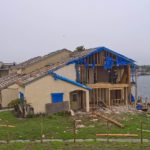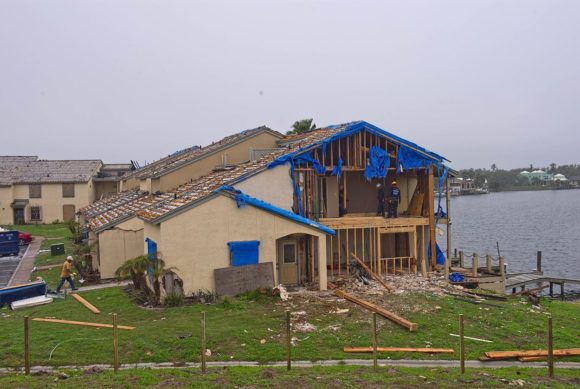Texas’ property insurer of last resort for wind and hail in counties along the Gulf Coast is finding itself once again between a rock and a hard place — or perhaps more appropriately, between a hurricane and a tornado — when it comes to creating a rate structure that is actuarially sound, conforms to legislative requirements and can be tolerated by its policyholders.
The Texas Windstorm Insurance Association received more than 400 written comments prior to an Oct. 17 publicly held meeting of the association’s actuarial committee, the primary focus of which was to determine what level of rate increase, if any, to recommend to TWIA’s board of directors. The overwhelming majority of those written comments submitted by coastal business interests, legislators, insurance agents and TWIA policyholders were against any rate hike. One of the biggest arguments against a possible rate increase was that the coastal areas hit by Hurricane Harvey in 2017 continue to struggle to rebuild after that devastating storm. Homeowners said higher insurance costs would force them out their homes, and business groups and elected officials said higher rates would hamper the coastal economies.
TWIA’s actuarial and underwriting committee postponed making a recommendation on rates at the Oct. 17 meeting so that TWIA’s staff could evaluate objections brought by one of its members, but the committee meets again on Nov. 19 to reconsider the rate issue again.
At the Oct. 17 meeting, the committee heard in-person comments from nine outside parties, including state lawmakers, leaders of banking, building and real estate associations, and representatives of local governments. All expressed their opposition to any rate increase proposal.

TWIA is required annually to submit a rate filing in August to the Texas Department of Insurance. Its August 2019 filing proposed a 0% rate increase, but at its meeting in early August, TWIA’s board left open the possibility of a future rate increase and instructed the actuarial committee to come up with a recommendation. The board meets again in early December and the committee is tasked with making a rate recommendation before that date.
In August 2018, TWIA filed for a 10% rate hike that was postponed at the request of Gov. Greg Abbott until after the Texas Legislature convened in 2019 in order to give state lawmakers to look at and take possible action on TWIA’s funding and operating procedures. TWIA decided in late May to withdraw the filing.
Rep. Mayes Middleton (District 23), who represents parts of Galveston and Chambers Counties, asked the committee not to vote on or recommend any rate increases at the Oct. 17 meeting. He noted a number of outstanding issues with regard to TWIA stemming from previously passed legislation, specifically, HB 1900 and SB 615. It’s premature to make any decisions on rates because “SB 615 and HB 1900 have not been fully implemented,” he said.
Middleton expressed frustration that certain aspects of the lawmakers’ intent with those two bills have not yet been met. Among other things, he cited the issue of one- in 100-year storm modeling, stating: “Unfortunately our intent has not been carried out [with HB 1900]. What that was that the one- in 100-year storm modeling would stay the same from last policy year, and it hasn’t. What we’re seeing now is that it appears the modeling has been changed or manipulated in some way. What that means is that the excess above a 100-year storm is being passed on to the policyholders. That was certainly not the intent of House Bill 1900.”
Instead, Middleton said, “we intended that the member insurance companies in the TWIA pool pay for any excess reinsurance costs above the one- in a 100-year storm. And by changing that model, you’ve shifted more of the cost to the ratepayers, which is totally against what we wanted with House Bill 1900.”
In late July, TWIA released its Rate Adequacy Analysis for 2019 that showed the association’s rates for residential coverage are inadequate by 41.7 percent and its commercial rates are inadequate by 50 percent. During the committee meeting, consulting actuary Steve Alexander raised several questions regarding the methodology TWIA used in its analysis. He took issue with, among other things, the association’s assumptions regarding the refinancing and repayment of bonds, its reliance on what he called “incorrect historical hurricane frequencies,” and the reinsurance provisions in the analysis.
TWIA Chief Financial Officer Jerry Fadden, however, defended the association’s work on its rate adequacy analysis and said staff not only disagrees with Alexander’s assumptions, they believe their analysis complies with HB 1900 with regard to hurricane modeling. “We disagree with the fundamental premise that we haven’t complied with 1900 or 615,” Fadden said.
The committee decided to give staff more time to respond to Alexander’s conclusions.
The Private Insurance Market
The private property/casualty insurance market has a stake in whether TWIA’s finances are up to the task of paying claims for future catastrophic events, as property insurers are “committed to $1 billion each year for potential TWIA losses. That $1 billion is an assessment recovered from all Texans through their policy premiums,” the Insurance Council of Texas (ICT) said in a media release dated Oct. 17.
The ICT is a trade organization and information channel representing property/casualty insurers in the state. Its 2019 State of the Property and Casualty Insurance Market report shows that the private P/C insurance market writes over $500 million in auto, residential and commercial premiums along the Texas coast and $49 billion in P/C premiums overall across the state. The report also shows that Texas has more than a “trillion dollars of coastal property at risk to hurricanes.” According to the ICT, private insurers write 52% of the wind and hail policies for Texas coastal properties.
As of May 31, 2019, TWIA had paid out to policyholders $1.25 billion for claims related to Hurricane Harvey. The association entered the 2019 hurricane season with $4.2 billion in available funds.
Under state law, TWIA’s rates must not only be sound from an actuarial standpoint, they can’t undercut those of the private insurance market, and they should not be unfairly biased against any population group.
In its Oct. 17 release, the ICT said the group “strongly urges that dialogue based on facts and analysis be at the core of rhetoric among all parties, elected officials, civic, government and business leaders. These leaders have a crucial role to play ensuring the solvency and financial stability of TWIA and all insurance carriers so that when Texans are devastated by losses, the promise made by an insurance policy is fulfilled.”
Likewise, in ICT’s October 2019 newsletter, Executive Director Albert Betts wrote that any discussion of TWIA’s rates should focus on insurance principles and solvency.
“Public pleas and failure to ignore sound insurance principles places TWIA at risk of having insufficient funds to pay claims and shifts responsibility for paying coastal losses to all Texas insureds through company assessments ($282 million for Harvey). All Texans have an interest in ensuring that TWIA makes decisions based on insurance and risk, and not on rhetoric and misinformation,” Betts wrote.
Related:
- Higher Limits of Liability for 2020 Disapproved for Texas Windstorm Insurer
- Texas Windstorm Insurer: New Laws Bring Organizational Changes
Topics Catastrophe Natural Disasters Carriers Texas Legislation Windstorm Pricing Trends Hurricane Property Property Casualty Market
Was this article valuable?
Here are more articles you may enjoy.



 Three Top P/C Insurers Account for Most of Insurance AI Patents
Three Top P/C Insurers Account for Most of Insurance AI Patents  US P/C Posts $35B YTD Underwriting Gain; By-Line Premium Growth Revealed
US P/C Posts $35B YTD Underwriting Gain; By-Line Premium Growth Revealed  Aon Extends Employment Agreement With CEO Case
Aon Extends Employment Agreement With CEO Case  Longtime Motel 6 Spokesman Tom Bodett Settles Lawsuit Against Chain
Longtime Motel 6 Spokesman Tom Bodett Settles Lawsuit Against Chain 

